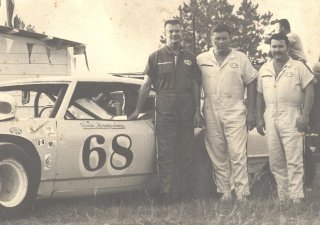
Driver Harvey Jones, and car owners, builders and mechanics Johnny Cooper and James Cooper with their race car at the Thunderbowl Speedway in Valdosta, GA.
By Mike Bell
Posted in Feature Stories 7/27/12
Do you remember going through all those small South Georgia towns and seeing some kind of race car at a garage or gas station? This is the story of one of those little towns and three brothers that had a garage just like that. The place? Ray City. The time? Late sixties into the seventies and later. Johnny Cooper is the oldest and grew up fast in that little town. The Cooper brothers are, from oldest to youngest, Johnny (July 22, 1945), James (August 18, 1947) and Tommy (August 27, 1956 – who has always gone by the name Skeeter and prefers it that way. “My uncle gave me that name is what my mother told me”).
Before the weather got hot a few years back, Jerry Ivey and I went to Ray City, Georgia to meet the Cooper brothers at their garage on the highway east of town. It is an old cinder block building that looks like it has been added onto at least once. It sits just far enough off the road where you could unload a trailer and still be off the roadway.
They are a big family. The eldest, Johnny, gave us a background on his family.
“Daddy was John T. Cooper,” he said. “Our mother was Sarah Lucelle Merritt Cooper. He worked for the railroad as a welder but had a garage and worked on cars on the side and farmed. But he was a construction worker. There was a small construction company and he was in charge of the company – Studstill Construction. He also worked at Moody Air Force Base near Valdosta as a mechanic and as parts manager.
“Mother was deaf. She worked on the farm. I am the oldest. We had two brothers killed in car wrecks at different times – Jerome and Danny Ray. We had one sister killed in a car wreck also. Her name was Betty Joyce. She was killed in the wreck, also. There was Linda Sue, Betty Joyce, Glenda Carol, Martha Jean and Brenda Faye. The three of us were born in Coffee County (near Douglas) in a little community called Westgreen, northeast of Douglas. We all went to school in Coffee and Berrien County. I dropped out of the 10th grade in 1964. I was married to Ruby in 1965 and we had two boys – Michael and Stephen”
James told us, “I got married in 1966 right before I went into the service. I graduated in the Army. I spent 2 years from 1966 to 1968 in the Army. We had two children – a boy named Tim (called Timbo by all) and a daughter named Misty”
Skeeter graduated from Berrien County High School in 1974. Skeeter’s family life seemed plagued until he met his present wife, Rachel. She is the sister of Timbo’s wife, Missy.
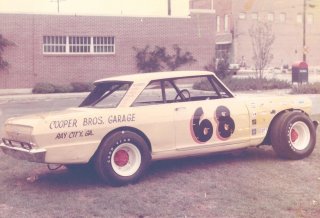
This is the first car that the Cooper brothers built sitting in front of the Post Office in downtown Ray City, GA. It was a Nova with a big block Chevrolet that Johnny drove at first but then Harvey Jones drove it.
When we talked about racing, Johnny remarked, “I started out as a fan. I use to help a guy named Preston Driscoll. First, I helped my brother-in-law, Earl Bristol, with his figure 8 car. Then helped on a little ’35 Chevrolet sportsman with Preston and we ran the Thunderbowl with that. I was tagging along and helping with that. We had a Buick engine in that Chevrolet. We wanted to run a Chevrolet but you just couldn’t find them. We had stopped about two in the afternoon to have a cup of coffee and my daddy said, ‘Why don’t y’all use the motor out of my car?’ He had a 1956 Chevrolet. Before he finished his coffee, we had our Chevrolet engine. We put that engine in the ’35 Chevy and went to the Thunderbowl and raced that night. I built me a 1954 Ford to run at Pavo. That was when Pavo first started racing. They had started running late models. I’ve had a shop since I was 14 years old. Daddy had always had a shop but he became disabled with emphysema and died with cancer. He taught us to weld and mechanic and work on cars.
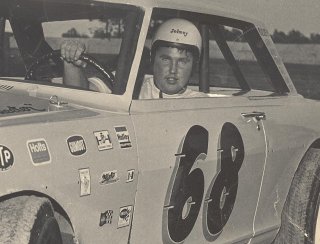
Johnny Cooper tried driving at first. He had been very successful drag racing but decided to leave the circle tracks up to Harvey Jones.
“My first excursion with racing was hanging around guys that had hot rods and messing around in the streets. The road out here use to be the main thoroughfare to Florida. Coo Coo Marlin (father of NASCAR driver Sterling Marlin) came through Ray City flat towing his car from Tennessee. It was a 1960 Chevrolet and he stopped at the intersection in town. That just thrilled me that he came through here. Later, a man was coming through town from up the country and his transmission went out on him. I bought that car from him for $50. And I built me a race car out of it and we ran Figure 8 races at ‘75’ Speedway with it. I was about 15 or 16 when I built the car. I didn’t worry too much about driving around here before I got my license. It wasn’t against the law as long as you didn’t get caught. And if you got caught, you were in trouble. I pretty much have been on my own since I was about 14. I had worked on the farm and learned how to drive at an early age.”
Johnny ran an O stock at US 19 Dragway in the middle sixties. It was a ’55 Chevrolet.
“I still hold the O stock record for the NHRA today,” he said. “I actually set a record faster then the N stock class. They took my car and disassembled it to verify my class record.”
James talked about his beginnings in racing.
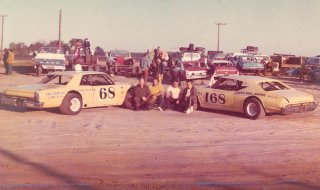
The 1965 Chevelle is on the left that Harvey Jones drove and the 1968 Chevelle is on the right that Don Williams drove at Valdosta with from left to right Jim Dowdy, Doug Herd, Johnny Cooper and an unidentified person.
“I went to races as a young man just to watch before I went off in the military,” he said. “We started racing when I came back out of the military in 1968. I went to one race while I was in the military up in Washington State. When I got back, we started this shop and owning race cars.”
Skeeter then spoke up about his early years.
“Actually I went to my first race with Johnny and his wife when I was about 10 years old,” he told us. “We went to I-75 Speedway. Every Saturday night they went, I had to go. When I was 12 years old, I went to camp near Brunswick with the church. It was getting close to Saturday and I didn’t think anybody was going to come get me so I went to calling everyone I knew in Ray City to come get me. When we got back on the bus, the shop was up there at the intersection and that was the first place I landed. I thought I was getting left.”
Johnny told us about the first race car.
“The first car we had together was a ’56 Chevrolet,” he said. “We bought the car from a man that ran an appliance store out of Moultrie named Sonny Croft and it was already together. We rebuilt it. We just got a car – no engine. Another man told me about a place in Lake City, Florida. There was a 454 Chevrolet torn apart but they couldn’t get it to run. We only gave $200 for it. We brought it home in boxes. We put it together and went racing. We always ran big blocks until they outlawed them. The first car we built together (Johnny and James) was a 1962 Nova on a 1955 Chevrolet frame in the early seventies.
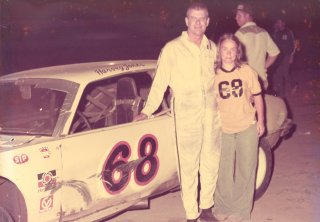
This is Harvey Jones with Glenda Cooper at the time. She is Mrs. Jimmy Alexander now from Hahira. Photo was taken in 1977 or so.
“Then we built a little Nova and I drove it some. I drove a sportsman some but never liked it. Harvey (Jones) started driving the Nova for us. We built a ’68 Chevelle with a Chevelle frame and Harvey drove that one, also. We rolled that ole’ thing several times but we would just fix the body and go on. Then we built the ’64 and he drove it for us. He would drive one and I would drive the other. One night at the Thunderbowl, he was running first and I was running second. Something went wrong with his car but he wouldn’t move over. He said if I was gonna drive, I needed to learn how to pass on the outside. That was just the way he was. We really didn’t worry about the weight with the big blocks. But then we went to managing our weight and tube chassis. In all our years of racing, we only had one full built chassis and we still have it. We never owned a store bought engine. Jack Patrick did all the machine work but we designed and built all our engines right in this shop. With the big block engines I would just modify the Chevrolet parts and go.
“Working at the Air Force base, we had an advantage. People didn’t realize back in those days that there wasn’t any such thing as racing fuel, unless you got something from way off. Everybody made their own fuel. We would start on Monday making our own fuel and be through maybe by Thursday. We could use the fuel lab at the base. The boys in the lab were real good friends. Fuel was the trick. Harvey Jones taught us that. He never would tell us what he ran but he would always say we had a pretty good mixture.
“The combination of good engine and carburetion and fuel mixture was the trick. We always did our own head work right here at this shop. We did everything but the balancing and block work – deck the block, align boring the crank and boring the cylinders. Then we built the engine at this shop.
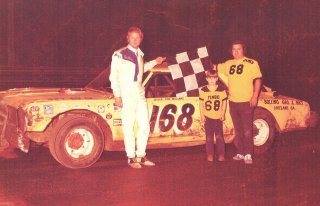
The driver Don Williams stands with the checkered flag with Johnny and his son Tim. We assume it is Columbia County because the track looks like asphalt but is really oiled-dirt.
“We took a car to Daytona in 1979. Of course we lost it but we did all the work right here in this shop. We took it to John Reed’s shop in Decatur (GA) and he dynode it for us. We had bought all the stuff from John. We took two dirt cars and one asphalt car to Daytona. Harvey drove one of the dirt track cars at Volusia and Don Williams drove the other and the asphalt car at Daytona.
“When Don went out with the asphalt car, it started smoking. He came in and we found out that we had burned a piston. We were in such a hurry that when we picked up the engine from John Reed’s shop it still had the dyno carburetor on it. We called John and confirmed that he still had our carburetor. He sent it and a new piston. We only had one engine. We took it out and took it back to the motel room on Monday and disassembled it in the motel room. John airfreighted the parts to us; got them at the airport about 3:30 in the afternoon. We went to Smokey Yunick’s shop to get it set up for the engine. He wouldn’t touch the piston. He told us where we could take it but he wouldn’t recommend them and it was his own son. A man that worked for his son flat cut the piston for us. We got back to the motel room and finished the engine about 5:30. We went back to the track but they wouldn’t let us in after 5:00PM. We had a van truck and couldn’t go through the tunnel so we had to go across the track but that gate closed at 5:00PM.
“Next morning about daylight, we got in there and put the engine in and got qualified on Wednesday. But we still didn’t have the right carburetor. For some reason, I don’t know why, Dale Earnhardt walked through and wanted to know what was wrong. I told him the carburetor wasn’t right and it caused us to burn a piston on Monday. He said to take it over to his truck and have his carburetor man fix it. We did and got qualified. But that was the kind of man he was. He didn’t know me from nothing but yet he helped us get to qualify the car. Later on we bought some cams from him through his speed shop in North Carolina. Had we been able to qualify on Monday like we were supposed to, we would have started 12th overall.”
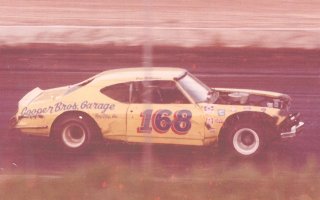
Don Williams in the Cooper brothers 1968 Chevelle with a big block at Columbia County.
“We had bought the car up in Cordele. Don Williams had never driven at Daytona before,” Johnny told us. James told us, “Don had to go through a training class before they would let him drive on the track.”
“We started 33rd,” Johnny continued. “There were about six or eight guys qualified for the race that we had run with on dirt. One was Morgan Shepard. We had run with him at Brunswick and Waycross. Dennis Bennett and the Snow brothers were there, too. Well, Morgan got everybody together and talked about drafting. But he told them that if they felt that they could go on to drop down and go on by everybody. After a few laps, Don was about fifth in line. He dropped down and passed them all in line down the back straightaway and went on. In about five laps he was way out in front of that group. We averaged 193 on Friday. There was a sixteen-car pile up on the back straightaway and a drive shaft got loose and came through the right window and hit Don which led to his death some 10 years later. We had known Don a long time. We use to help him with his little sportsman car.”
There is more to the story than what Johnny told us. His younger sister, Glenda Alexander, sent us an article that was written in October 1979, almost 8 months after the wreck. Through no fault of anyone, Don Williams laid in a coma for 10 YEARS after the wreck. The article is about the Williams family struggling to take care of Don and Daytona didn’t seem to want to help. You won’t find many NASCAR tracks in South Georgia and North Florida these days. Don Williams looked forward to a promising career in racing. He was described in the article as being a “solid citizen, Florida State graduate, model son, on-the-road ball bearing salesman.” When you look at photos, he could have been a movie star. All that ended on lap four of the Permatex 300. His injuries included a chest injury, a broken arm and a hairline skull fracture, which led to brain damage and all his troubles. Joe Frasson, who was also involved in the wreck that enveloped his car with flames, walked away from it all.
“When we came home from Daytona both dirt late model cars and the asphalt Permatex late model car were totaled. We use to go to Barberville and race for nine straight nights with Harvey.
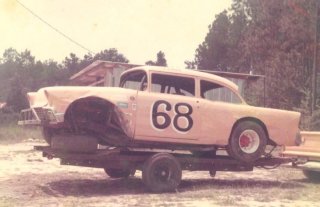
The first late model the Cooper brothers had. The car was bought from Sonny Croft of Moultrie but the big block came from Lake City in pieces.
“We raced at the dirt track south of Lake City for awhile. We won a lot of races down there. I don’t recall the man’s name who ran the track but he put on 54 races at the track and we won 49 of them. At one time he told us he would pay us if we didn’t come back. He was gonna pay us for five races just so we would stay away. We took his money and never went back. He only ran about seven or eight more races there. They protested our heads that last night.
“They even checked our fuel. The track went out and bought one of those expensive fuel gauges. That night they checked everybody in the pits. They were all illegal but us. I use to have a little brown bottle we had for over 15 years. We carried it to all the races. I would take it out and pour it in the gas can and shake it all up with the fuel. But there wasn’t anything in it but vanilla flavoring. Ronnie Lieupo use to tell us that we had the sweetest smelling car he ever knew. Nobody ever knew what we had.”
The Cooper brothers had quite a few drivers after that.
“Preston Driskell’s nephew Tommy Smith drove for us,” Johnny said. “Eldon Yarbrough drove for us at Waycross and Sam McQuagg drove for us at Barberville one night. Tommy won 14 feature races for us at the Thunderbowl and a championship, and he and his wife had some problems and he quit driving for us. He had driven some of the Hav-A-Tampa races for us. Tommy was a good aggressive driver for us. He was not a smart driver some times.
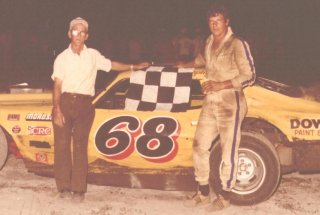
Johnny and James’s father poses with Jimmy Murphy after a win with the Mike Bostic built car.
“We’ve won races at Patton Speedway, Lake City Speedway, Columbia County, Jacksonville, Waycross, Brunswick, Telfair County Speedway, Dublin, Cordele, both tracks in Phenix City, Albany, ‘75’ Speedway, Thunderbowl, Ocala, and Satsuma (Palatka, FL). We even ran a Hav-A-Tampa race at Pennsboro, WV. You know that it has two bridges on it. There is a little stream that runs through there. I told everybody that we don’t have a chance. Our driver will run into the bridge and sure enough on about the third lap he hit it. We didn’t make the race. Missed it by one position.
“We won the Hav-A-Tampa race at Lake City Speedway. We ran every Hav-A-Tampa race we could. Working in the military, we just couldn’t get off work to go race. Harvey drove the first Nova then the ’68 then the ’64 and then we built another Nova (’68). He even drove some of the wedge cars for us. He left us to drive his own late model. But it was years before he won in his late model. He started winning at Cordele and won a lot on his own up there.
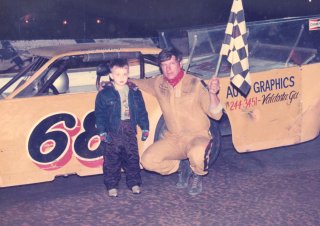
This is a win at the Thunderbowl at a special New Year’s Day race for driver Jimmy Murphy driving the Cooper brothers car with Jimmy Alexander’s son Dusty.
“Jimmy Murphy started driving for us then. He had never driven a late model before he started driving for us. He had only driven the sportsman cars (straight axle cars with early ‘30’s bodies). He and Ronnie Lieupo ran together in the sportsman.” Jimmy won 49 features for the Cooper Brothers – one of which was the Hav-A-Tampa race.
“We have had the striped ass ape on our cars for years. We started out with a Wylie Coyote strangling the Road Runner. But then our car was a star in that movie they made at the Thunderbowl. Dub Taylor (his character) drove the car. Actually Harvey drove the car. I wanted something on the car that was different. You use to get several bumper stickers when you order came from Honest Charley. It kinda says ‘get what you want and get out.’
Johnny then told us the story of why they quit racing.
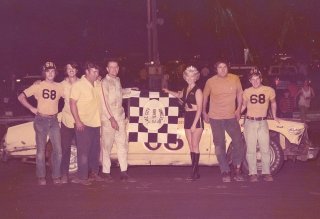
Trophy presentation at Lake City during their 12th anniversary. Left to right is Gerald, Leslie Jones, Johnny Cooper, Harvey Jones, Beauty Queen Barbara McCray, Doug Herd and Skeeter Cooper.
“When we quit racing, James had gone to ministering and we got robbed,” he said. “We have the last car in the shop now. It has only three races on it. It’s a Warrior design but Russell Brown put it together. We raced at Waycross, Brunswick and Jacksonville. We came back on Saturday night and unloaded the car from the trailer to the garage on December 22, 2002. They stole whatever they wanted – $48,000 worth. James wanted to go to a ministry in Alaska (which he did for some five years). I was about to retire and just couldn’t afford to start over. We caught them and they were from Lake County, Florida down near Lake Okeechobee. But they had sold everything. Boy was only 23 years old. His daddy had had him stealing since he was three years old.
“We did take the car down to a party they had for Jimmy Murphy. He was pretty sick and weak then. I didn’t take the car down personally but someone else took it. When I got there, Jimmy asked me if it would crank. I told him it wasn’t a race car unless it would crank. We started it up and he just smiled. Then he asked me if he could drive it. I told him he could but his momma and his wife was just a hollering for him not to drive it. Skeeter helped him in the car. After he got the steering wheel all set, off he went – out of the parking lot and down the street – tires just a smoking. He turned around and raced back down to the parking lot. I was real thankful he hadn’t wrecked it but here came the law. We had to talk the officers out of arresting Jimmy. That was the last time it was raced. Jimmy is getting better everyday now.”
Johnny finished the story with a note for his supporters.
“There are just so many people that supported us through the years that I can’t name them all.”
Mike Bell is a Georgia racing historian and volunteer for the Georgia Racing Hall of Fame.
Questions, comments, suggestions? Email us!
This website is not affiliated with or endorsed by the Georgia Racing Hall of Fame or the Georgia Auto Racing Hall of Fame Association, Inc. All content is the intellectual property of the individual authors. All opinions are those of the individual authors. Please do not repost images or text without permission.
